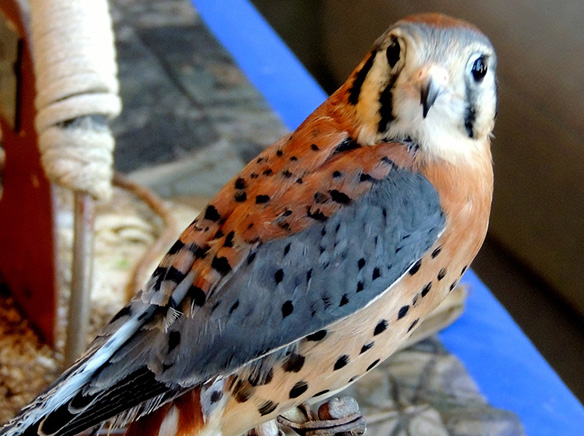Mission Trails Regional Park held an open house for families wanting a close-up look at nature on May 17. The event honored endangered species as part of Mission Trails Day. Music of the Native American Flute Players soared throughout the center as people visited the different tables. Kristen Gay was just one of the many people who did a double take as they walked by the American kestrel, barn owl and screech owl at the Sky Hunters table. Gay stopped in her tracks when she saw the little screech owl blink.
Mission Trails Regional Park held an open house for families wanting a close-up look at nature on May 17. The event honored endangered species as part of Mission Trails Day. Music of the Native American Flute Players soared throughout the center as people visited the different tables. Kristen Gay was just one of the many people who did a double take as they walked by the American kestrel, barn owl and screech owl at the Sky Hunters table. Gay stopped in her tracks when she saw the little screech owl blink.
“The birds are real! At first, I thought they were stuffed,” she said, laughing. Gay leaned in closer to look into the face of the snowy barn owl. “I just love owls,” Gay said.
Nancy Conney, director of Sky Hunters, smiled. “It’s a girl thing,” she said. “Guys like strong birds like the falcons.”
Even so, Michael Alexander was admiring the owls too. He had many questions for Conney about the owls.
“Owls eat small rodents such as mice. Owls are migratory birds. And owls can’t see to the left or to the right, so they are able to turn their heads 270 degrees,” Conney said.
The Western screech owl weighs only 110 grams. They make their nests in trees but they will also use owl boxes.
“When they screech, it sounds like a scream by a lady who has just seen a mouse,” Conney said.
Barn owls will nest in trees and towers. Their call is the familiar “hoot, hoot, hoot.” Like most owls, the barn owls mate for life,” Conney explained.
“Now that’s interesting,” Julie McCoy said.
“Yes, but they live separately,” she said. McCoy and Alexander laughed.
“I feel like I’ve had my owl 101 lessons. I’ve learned today more about owls than ever before,” McCoy said.
An American kestrel on a perch next to the owls had people stopping to stare too.
“He’s our diurnal bird. He hunts during the day,” Conney said.
Conney’s assistant Laura Webster made sure that the children did not get too close to the kestrel, which intermittently bobbed his head.
“That’s his way of focusing better,” Webster explained. “You’ll see hawks doing that too, like Cooper’s hawks.”
The kestrel, 3 years old, was brought to Conney when he was just a baby.
“He had imprinted on a lady for a year, so he wasn’t able to catch his own live food. The lady dropped him off at the veterinarian’s office,” Conney said.
In fact, all the birds that Conney has in her care were sick, injured or orphaned wildlife. She is commissioned by the U.S. Fish and Wildlife Service to care for them.
“People call me from 6 a.m. till midnight with the need to take on a wild bird,” Conney said.
Jay Wilson, executive director of Mission Trails Regional Park, stopped by to greet Conney and her visitors.
Wilson told a story of one night when George Varga had one of his star parties in the visitor center’s amphitheater, showing people the stars through his telescope. The sky had been rather murky, so the people began to lose interest.
In the meantime, there was a barn owl in the tree just 200 feet away.
“We knew he was up there because we could hear his hoots. The owl stayed up in that tree for 90 minutes. People were fascinated to hear and see him,” Wilson said.
Wilson favors educational events such as the Mission Trails Day so that the public can learn as much as possible.
“Organizations like Sky Hunters make sure that people understand the importance of our native species, which we have right here in our open space park in the middle of an urban community,” he said
With the wildfires on everyone’s mind, Conney reassured people that she had plenty of time and resources to move the birds if necessary.
“When I see those flames coming over the hills, I know it’s time to leave. The birds all have their own misters and crates. I just load them up and take off with them,” she said.
Jay Wilson, executive director of Mission Trails Regional Park, stopped by to admire the owls and kestrels, among other birds of prey on the endangered species list. These birds’ biggest predators happen to be human.
Owls, falcons and kestrels are all prey to pellet or BB guns that kids use. “Parents need to supervise the use of these guns,” Conney said.
The other danger to raptors is poison.
“The birds eat the rodents that ate the poison intended for the rodents. The birds then feed their babies the poisoned rodents and it passes through the generations.
“In order to prevent this happening, it’s best to trap and release rodents,” she said.
To help educate about raptors, donations may be made to Sky Hunters. Sponsorship of a bird of prey entitles the giver to a color photo of the sponsored bird, a certificate of sponsorship, newsletter and membership.
Call 619-445-6565 for information on presentations and sponsorships or go to www.skyhunters.org.














